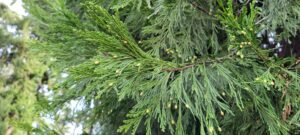Tag: winter
MLK Day of Action in a Wintery West Eugene

Justice was top of mind for everyone at the West Eugene Martin Luther King Day planting on Saturday January 20th. The event had been postponed from earlier in the week because of the winter storm that brought ice, frigid temperatures, downed trees, and power outages. Luckily by Saturday, Eugene had thawed out enough for three crews of volunteers to plant 25 trees in their community.
“It was cold, but everyone was so excited and kept up their spirits,” says Eugene Director Erik Burke.
After a week of harsh winter weather, people were excited to get outdoors. The planting started at Berkeley Park in West Eugene, a high priority planting area. Spurred by a call to do something for their community, all three crews traveled to their planting sites on foot rather than in cars. The intimate events that our Eugene team hosts create an atmosphere of connection that is perfect for the MLK Day holiday.
Much of the conversation that day was about the winter storm and the hardships people either avoided or endured depending on how lucky they were.
“Downed trees aren’t just a tree maintenance issue or a climate change issue,” Erik says. “It’s a justice issue. Trees that don’t receive proper care are more likely to fail. If we want everyone to have access to the benefits of trees, we need to make sure that tree care and maintenance is available too.”
Just like we do at every planting event, we highlight how planting trees is just the beginning. Tree care and community stewardship is the path to long-lasting trees, whose benefits increase exponentially as they mature. Planting is climate action worthy of a day of service. Caring for trees and communities is a daily practice.
Together we can protect trees and our communities: Friends of Trees Op-Ed
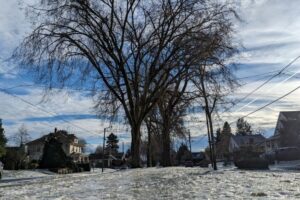
On January 21st, The Oregonian published an op-ed written by Yashar Vasef, our executive director, and Litzy Venturi, our community tree care coordinator: “We must invest in tree care to protect trees and our communities.” Read the full piece below.
Opinion: We must invest in tree care to protect trees and our communities
Climate change and its severe impacts force us to live with dual realities: We need trees more than ever and we need to recognize that extreme weather can turn them into hazards. After hundreds of trees and large limbs fell around the Portland metro area during this historic winter storm, we know that people may be concerned about the trees in their neighborhoods. The impact of a downed tree is serious and often devastating.
The response is clear, but not necessarily easy. Not only do we need to continue to plant trees to grow our urban canopy, but we also need to invest more time, knowledge and resources into assessing, protecting and maintaining the trees we have. As part of that, we must also deal with trees that need to be removed and replaced due to poor health or the potential threat they pose to homes or businesses.
Trees are a crucial ingredient for a healthy, resilient and livable community. How do we set our trees up for success in the face of potential extreme weather? It starts with planting the right tree in the right place. Sometimes people favor certain species because of sentiment or aesthetic appeal, but if they aren’t planted in a place with the right conditions, they’re more prone to failure. Selecting a tree for the available space, light and soil type is the first step in giving a tree a long healthy life.
The next step is to invest in caring for young trees after they’re planted. Proper watering techniques encourage roots to spread into a wide, stable network. Mulching around a tree’s root zone provides the soil with needed nutrients and structure. The right pruning plan will allow a tree to establish a strong trunk and a stable shape and mitigate the risk of limb failure. Tree care is a lot like preventative medicine. Keeping a tree healthy will reduce the risk of catastrophic failure.
You might be looking at a large tree in your own yard and wondering what to do next. While concern after this winter storm is natural, it’s important to remember that the benefits of trees far outweigh the risks. Trees create oxygen, abate pollution and cool our neighborhoods. It’s important not to over-correct by removing healthy trees. This was an unusually catastrophic weather event, and while hundreds of trees fell, millions didn’t. Still, there are steps you can take as a tree owner, and that we can take as a community, to better care for our trees and reduce the risk of catastrophe in the future.
An arborist partner of ours, Chad Honl, pointed out in a recent Oregonian/OregonLive story that this was “a perfect storm for knocking over trees,” and that even trees he would have characterized as stable toppled over in the storm. That’s a scary prospect, especially as climate change increases chances for extreme weather. But it just means that we need to learn more about what happened – which kinds of trees fell and what factors may have made some more vulnerable to failing than others. We agree with Honl’s call for trees to be assessed and reassessed with storms like this in mind. Understanding and addressing risks in advance of the next storm can save a lot of money, trouble and even lives. If you’re worried about your tree, you should have it inspected by a certified arborist for maintenance needs and potential problems.
A greater investment in trees doesn’t just mean planting more trees. It means taking care of the trees we have. In response to the unexpected revenue from the Portland Clean Energy Fund, Portland City Commissioner Carmen Rubio has called for additional climate investments, including $100 million for the protection and maintenance of 240,000 right-of-way street trees between the sidewalk and the street. We need to protect our mature trees and protect our communities by making sure those trees are safe.
The more mature a tree gets, the more benefits it provides: more carbon storage, more air and water quality benefits, more shade, more habitat. That’s why we need to invest in the health of our trees, for our safety in the event of a winter storm or heat wave, for our daily mental and physical well-being, and for the health of the planet.
Eugene’s Winter Trees
Our Favorite Trees to Watch in Winter
Many trees have shed their leaves and are on their way to being dormant for the winter. But not all of them! Late fall and winter in Oregon and Washington is still a wonderful time to admire trees. Our Eugene team put together some of their favorites to watch out for this time of year.
One of the most brilliant fall trees is the gingko, whose intense yellow leaves tend to fall all at once, thanks to their unique stems. Although ginkgos have “broad” leaves, they are actually more closely related to conifers. The modern ginkgo has changed little since its ancestors first graced the planet more than 200 million years ago—tens of millions of years before the advent of conifers and more than a hundred million years before broad-leafed trees became abundant.

For many the Douglas-fir, Oregon’s state tree, is a quintessential evergreen conifer, especially as many of them head into our living rooms for the holidays. Douglas-fir dominates local woodlands, and is joined sometimes by valley ponderosa pine, incense-cedar, and grand fir.
Conifers like the Doug-fir are perfectly adapted to our area’s wet winters and dry summers. Part of what makes Eugene special is that while the urban forest is composed largely of broad-leafed deciduous trees, it’s punctuated with firs, incense-cedars, giant sequoias and other conifers.
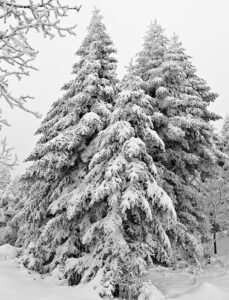
One of the many reasons we love evergreen conifers—they work year-round, producing oxygen and storing up carbon through photosynthesis, and providing important stormwater benefits by intercepting precipitation in their dense canopies.
Another favorite? The Atlas cedar, one of our true cedars. You can tell the cones of true cedars, like the atlas cedar, because they stick up vertically and shed their bracts one by one while staying attached to the tree.
The Atlas cedar notable is this time of year because it’s already releasing its pollen. Many conifers, in particular, “bloom” during late fall and winter. Atlas cedars (Cedrus atlantica) have exceptionally large and showy pollen cones, sometimes two to three inches in length and up to half an inch in diameter. The spent pollen cones are most noticeable after they have fallen, when they carpet the ground beneath the tree with what look like big, fuzzy, yellow caterpillars.
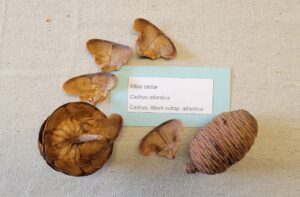
Keep in mind, wind pollinated trees are responsible for allergies, rather than showy flowers. Trees like the incense cedar will be putting out pollen in December. But the rain might save us—heavy rain will knock the particulates out of the air, cleaning them up for us.
Many people have the impression that, during the winter, trees—especially broad-leafed deciduous ones—are completely dormant. But thanks to relatively mild winters in western Oregon, it’s possible to find at least one species of broad-leafed tree—and sometimes several or more—in bloom during any given month of winter. In December, the long, dangling, pollen-bearing catkins of European filberts begin to develop—and the tiny, magenta female flowers do, too, though they’re not nearly as conspicuous. And in January, we begin to see the first elm flowers. Keep your eye out for these lovely signs of life!
Leaflet: Prepare Your Trees For Winter

Pruning techniques to make your trees more resilient to winter storms
The temperatures have dropped, and it’s probably just a matter of time before we get some serious winter weather. The best thing we can be doing this time of year to make our trees more storm resilient is pruning. We’re going to walk you through the pruning techniques that will help a tree if and when we get another serious winter storm.
As we’ve seen more and more in recent winters, the combination of wind and ice will lead to branch failure—in short, nature prunes itself. That’s exactly why it’s best to prune problem areas now rather than waiting until snow and ice is predicted. Ice can increase the weight load on a branch by up to 30 times.
For an even more in-depth guide to pruning, visit our pruning page.
Prune outside the branch collar. The most important technique when pruning any branch, whether it’s a quarter-inch or four inches diameter, is to prune just outside the branch collar. On some types of tree, the branch collar is obvious. It is that bit of swelling—like a collar—at the base of where the branch connects to the trunk. That swelling is an accumulation of healing hormones. If you cut flush against the trunk, you’re cutting away the hormones that will close it off and protect it from pests and diseases.
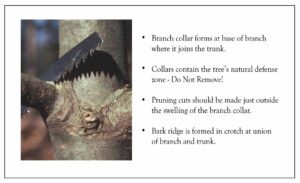
Remove the Ds. The best way to start is to look for branches that are dead, diseased, dying, or decaying— anything that starts with a D. Just take a nice pruning saw or or some hand pruners and prune that right out of the tree.
A small six- or seven-inch folding saw is really all that a homeowner needs. We could do 99% of what we end up doing with just hand pruners and a folding saw on a young tree.
Mind your pruning budget. You shouldn’t prune away more than 25% of your tree’s canopy. Leaves are effectively solar panels that produce energy for the tree, and you don’t want to remove too much of that. Sometimes people want to prune their trees to encourage it to grow taller, and they’ll prune all the lower branches and make a sort of lollipop. So another part of calculation is that two-thirds of the trunk needs to have lateral branches.
Dead and dying branches do not count toward that budget, because they are not producing energy for the tree. The tree wants to lose those anyway and, as we already mentioned, nature will more recklessly prune them away during the next storm if you don’t. Suckers—the small branches at the base of the trees—should also be removed. While they do have leaves, they also do not count toward that budget, because they could become so vigorous that they just take over.
Look for included bark. A wide angle between a lateral branch and the trunk creates better architecture than a sharper angle. When the angle is more acute, the bark will start to fold over itself in the crease at the connection point. This is called included bark. Branches with included bark are where more than 80% of failures happen.

There might be instances where pruning all the branches with included bark will take you beyond your pruning budget, in trees like Japanese maples, zelkova trees, or columnar (upright) cultivated varieties. There are ways to address included branches without removing them entirely. You can cut away the most vigorous upright branches along the branch, which will stop that branch from growing more. There is a gravity-fed hormone in upright branches that encourages growth. By removing the upright branches, you change the hormones to those for repair and reproduction and in doing so, slow the growth of the branch relative to the trunk.
Encourage a strong central trunk. We’re trying to prune trees to have a strong central trunk—or central leader. Some trees, like conifers, grow a central trunk naturally. Other trees want to have a more rounded canopy. We want to create a strong backbone so that a tree is more resilient to wind. It is a bit unnatural, but when we are planting trees in the built environment, we have safety considerations to keep in mind. If a tree is in the middle of a giant backyard, it can take a more natural shape, but if it’s somewhere where its branches could fall on a house or a car, it’s helpful to have that strong central trunk.
When you prune, look for a strong central leader on a young tree that can be encouraged as it matures, and prune away competitive side branches. The rule of thumb is that you don’t want to have any lateral branches that are more than half the diameter of the central leader. By keeping those side branches smaller, if they fail, it’s less likely to be catastrophic to the tree or its surroundings.
If a storm comes!
When a winter storm does arrive, what do you do? Shake off snow, but not ice. Light snow can be gently shaken from branches with a broom moved in an upward motion. Heavier snow and ice should be allowed to completely melt because branches with ice especially often fail when shaken.
Once the snow is gone, inspect your tree for damage, taking care to take safety precautions as necessary. You can use a pruning saw to cut away any dead or damaged branches at the nearest branch collar.
Pruning resources:
- We have an entire webpage on how to prune that gets into even deeper detail.
- If you have a bigger tree, and the task of pruning it is beyond you, get in touch with one of these recommended arborists.
- If you have a specific question that you just can’t crack, you can write our new email address for pruning questions: [email protected].

